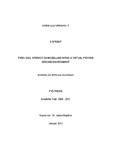JavaScript is disabled for your browser. Some features of this site may not work without it.
| dc.contributor.advisor | Brighton, James L. | |
| dc.contributor.author | Wright, A. | |
| dc.date.accessioned | 2013-05-15T19:02:46Z | |
| dc.date.available | 2013-05-15T19:02:46Z | |
| dc.date.issued | 2012-01 | |
| dc.identifier.uri | http://dspace.lib.cranfield.ac.uk/handle/1826/7904 | |
| dc.description.abstract | Off-road mobility defines the ability of land-based vehicles to accelerate, pull loads and climb gradients. Historically, much of the work completed to relate mobility to vehicle and terrain characteristics has been empirical in nature, and has therefore been susceptible to errors caused by the inherent variability of naturally occurring soils. This thesis addresses the off-road mobility of wheeled vehicles, and in particular the use of a finite element (FE) based approach to predict performance metrics such as rolling resistance, drawbar pull and tractive efficiency. Tools to predict these measures of performance have a wide range of applications, including military, agricultural and leisure vehicles, aircraft operating from temporary airfields and planetary landing craft. The current study extends the virtual proving ground (VPG) concept, where a single vehicle model can be subjected to a series of virtual test conditions, to include the assessment of off-road mobility. Throughout, modelling has been carried out using LS-DYNA, a commercially available non-linear dynamic analysis code. Unlike previous studies using FE techniques to investigate wheel / soil interaction, an Eulerian representation of the soil has been employed, which permits a consistent approach to be applied to both purely cohesive and purely frictional soils, as well as those displaying a combination of cohesive and frictional behaviour. At each stage of the research, the validity of the FE-based modelling approach has been assessed using data from controlled experimental testing at Cranfield University’s off-road dynamics facility. A key finding of the work completed is that rate sensitivity in moisture containing soils can significantly affect the accuracy of (empirical, analytical and numerical) model predictions, even at low translational speeds (less than 0.1m/s). This finding highights the adverse impact of simplifications in many previous experimental and modelling studies, which have assumed that rate effects may be ignored providing the translational speed of the vehicle is low. | en_UK |
| dc.language.iso | en | en_UK |
| dc.publisher | Cranfield University | en_UK |
| dc.rights | © Cranfield University 2012. All rights reserved. No part of this publication may be reproduced without the written permission of the copyright holder. | en_UK |
| dc.title | Tyre / soil interaction modelling within a virtual proving ground environment | en_UK |
| dc.type | Thesis or dissertation | en_UK |
| dc.type.qualificationlevel | Doctoral | en_UK |
| dc.type.qualificationname | PhD | en_UK |
